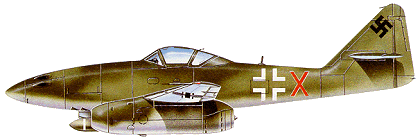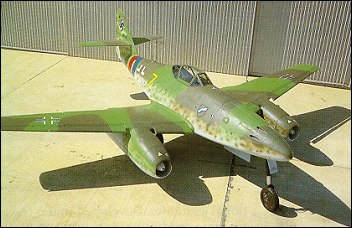|
| What would have been the outcome of the war in Europe if in 1940 the potential of Messerschmitt's Project 1065 had been appreciated by high authority? If a crash programme had been originated to put this turbojet-powered aircraft into service at a much earlier date, would the Luftwaffe have regained the initiative of the first two years of World War II?
Unfortunately the answers are not clear cut and there is no space here to discuss the pros and cons. It must suffice that the Me 262 (as the P.1065 became designated) was the world's first turbojet-powered aircraft to enter operational service - at Juvincourt, France on 10 July 1944. By then, however, the end of hostilities in Europe was only ten months away: the lack of a real plan for the deployment of these aircraft and the
inadequacy of tactics to gain full benefit of their' speed advantage could not be rectified in so short a time - especially under the chaotic conditions existing in Germany and with dwindling supplies of fuel .
Messerschmitt's P.1065 design had originated as early as 1938 when the Reichsluftfahrtministerium had requested the company to design a twin-engined fighter able to utilise the new turbojet engines being developed in Germany. After inspection of the mock-up, three prototypes were ordered on 1 June 1940. But because the engines to power the Me 262 had not been developed sufficiently, the first prototype flew initially with piston engines. It was not until 18 July 1942 that the first flight with all-turbojet power was recorded. (The Heinkel 280, which did not enter production, had flown before the Me 262, on 2 April 1941, so becoming the world's first twin-engined jet.)
Of conventional all-metal stressed-skin construction, the wing had moderate sweepback, long-span ailerons, trailing-edge flaps, and full-span automatic leading-edge slots. The engines were mounted beneath the wing to preclude a complex wing-spar structure and the landing gear was of retractable tailwheel type. The fifth prototype introduced a non-retractable nosewheel unit and the sixth was the first to have a fully retractable tricycle-type landing gear.
First major version was the Me 262A-1a Schwalbe (Swallow) interceptor, armed with four 30mm MK 108 cannon mounted in the nose. It was powered by two 8.825kN Junkers Jumo 109-004B-1 eight-stage axial-flow turbo-jets. A number of variants were built with differing armament. The other major version was the Me 262A-2a Sturmvogel (Stormbird) bomber. This was produced at the insistence of Adolf Hitler - a decision which caused considerable overall production delays. It carried, in addition to the standard MK 108 armament, one 1,000kg, two 500kg or two 250kg bombs. As with the Schwalbe, there were a number of variants, mainly for armed or unarmed reconnaissance.

| MODEL | Me-262A-1a |
| CREW | 1 |
| ENGINE | 2 x Junkers Jumo 004B-1/-2/-3, 8.82kN |
| WEIGHTS |
| Take-off weight | 6400 kg | 14110 lb |
| Empty weight | 3800 kg | 8378 lb |
| DIMENSIONS |
| Wingspan | 12.48 m | 41 ft 11 in |
| Length | 10.6 m | 35 ft 9 in |
| Height | 3.84 m | 13 ft 7 in |
| Wing area | 21.7 m2 | 233.58 sq ft |
| PERFORMANCE |
| Max. speed | 870 km/h | 541 mph |
| Ceiling | 11450 m | 37550 ft |
| Range | 1050 km | 652 miles |
| ARMAMENT | 4 x 30mm cannons |
 | A three-view drawing (1667 x 1123) |
| Dave, e-mail, 02.07.2009 23:53 I believe the 262 had the edge on the p80 in speed and weight of armament reply | | Dave, e-mail, 02.07.2009 23:50 Have read an article on the cannon equiped prototype stating it was 50mm - all in all look at the recoil of an 88 - 50mm would be bad enough in an aircraft that was'nt designed for it.The Henschel HS129 was a ground support aircraft and one version mounted a 75mm anti-tank gun - the barrel length almost looks like a PAK 40 Now thats impressive,but it was an aircraft designed for ground support,and the weapon was actually in a 'pod' underneath the fuselage. reply | | Jerry M. Noosinow, e-mail, 23.06.2009 08:45 I have seen a photo of the 262 with one large cannon in the nose. looks like an 88. Does anyoone have any info on this? reply | | Stu Stein, e-mail, 22.06.2009 19:59 Thanks to the COLLINGS FOUNDATION the ME-262 lives on with a ME-262 called White 1 that is flying with a National Tour called the Wings of Freedom Tour call 800.568.6924 for more info. reply | |
| | leo rudnicki, e-mail, 09.04.2009 19:27 I think you can compare the P80 with the Me262 if you consider the P59 as the technology demonstrator that it became. The P80 was a remarkable plane, and cetrifugal compressors were certainly more reliable during the days when metallurgical technology was in it`s infancy. So how does the new me262 compare to F5-T38 reply | | Mike O'Donnell, e-mail, 24.03.2009 20:17 What about the five "new" 262's built in Washington state? The aircraft builder got all the license requirements from MBB (the successor company to Messerschmidt) to build four single-seat and one two-seat trainer aircraft. The single seaters are officially designated as Me-262A-1c (the "c" suffix indicating the third engine type, the GE J85-CJ610. The 262A-1a had Junkers Jumo engines, the 262A-1b was powered by BMW jet engines).
The first 262A-1c was given the German civil registration number D-IMTT; the two-seater makes appearances at air shows in the US (and yes, you can go for a ride - for something like $9,000 for a half-hour flight). I understand the last three single-seaters are available for sale (if they haven't already been purchased). reply | | Guy Tremblay, e-mail, 09.11.2008 20:10 Compare the design with the Airbus 380. Almost the same
solutions, 60 years later reply | | Mahon MacRi, e-mail, 03.08.2008 06:00 Your information on the armament of the "schnellbomber" version is incorrect. Having read a great deal about the Me 262, I have discovered that the Sturmvogel (bomber) version only had TWO MK108 30mm cannon in the nose instead of the four mounted MK108 cannon mounted in the Schwalbe (fighter) version. The reason for this had to do with CG (centre of gravity) issues and the added weight of bombs carried in the nose area; bombs were carried immediately behind the nosewheel under the front end of the fuselage. reply | | wuwu, e-mail, 16.07.2008 23:33 Russel - you can not compare Me-262 with P-80, it's not the same level of jets evolution, you can compare P-80 with MiG-15, or Me-262 with Gloster Meteor. All at all, the Me-262 fought in the WW2, P-80 didn't. So there is one conclusion - at the same time Me-262 was more advanced than P-80.
regards reply | | Russell Taliaferro, e-mail, 18.05.2008 23:29 How did the performance of the ME262 compare with the Lockheed P-80? reply |
|
Do you have any comments?
|
| 
COMPANY
PROFILE
All the World's Rotorcraft
|








